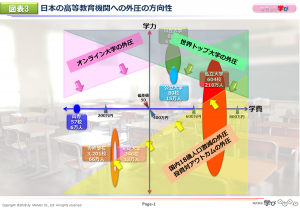[3] How do the three external pressures affect Japanese higher education institutions?
The external pressure to promote university selection toward 2100 has been divided into three categories: 1. Population transition and economic changes, 2. Science and technology evolution, 3. University changes and administrative measures. Chart 3 illustrates the three external pressures that promote university selection.
this is,"Current Status of University Reform and Its Whereabouts" Chart 4 of the 1th Part XNUMX (Distribution image of Japanese higher education institutions)Based on the positioning map of Japanese higher education institutions shown in Figure 2, the directions of the three external pressures shown in Chart 3 are superimposed and schematized.
The first external pressure (yellow), "population transition and economic changes," is likely to promote the decline of the Japanese economy and reduce tuition fees for higher education.Therefore, the needs toward the left side of Chart 3 will expand.The number of universities that can survive will depend on how much public funds are invested as scholarships to universities or those who wish to go on to higher education.In addition, the drastic decrease in the domestic 18-year-old population will be the external pressure of the selection of higher education institutions from the bottom to the top.Selection from private universities with low investment-to-outcomes (high tuition and low outcomes) will accelerate.
Next, the second external pressure (pink), "evolution of science and technology," is the need of universities with high investment-to-outcomes (high outcomes but low tuition fees) represented by Minerva University from free online learning. ..Needs will expand from the upper left to the lower right.From the moment the "language barrier" of simultaneous interpreters is removed, this need is likely to be greatest, as high investment vs. outcome (high outcome / low tuition) universities expand and online is the mainstream. Oligopoly progresses.
In Japan, this market has a university communication system and some online universities.However, in the future, competition with overseas financially rich and advanced technology-based online universities will intensify.
In addition, the evolution of artificial intelligence will change the way of profession and the way of education.Universities that are knowledge-oriented and select entrance exams, such as national universities, and are centered on knowledge education will be replaced by education using artificial intelligence, and human resources who have left that university will be replaced by robots with artificial intelligence. ..
Finally, the third external pressure (green), "University Change and Administrative Measures," is under the pressure of the world's top-class universities (high outcomes / high tuition fees) that maximize the outcomes that can be active in the world, albeit at a high price. be.With the development of each country in Asia and Africa, it is predicted that the world's leading universities with abundant finances will be scattered all over the world.High school students who are financially strong and motivated are more likely to study abroad at top universities overseas instead of at domestic universities.In addition, by promoting the oligopoly of high-priced but high-outcome online-type universities (which can be taken in virtual reality with the evolution of science and technology) to world-class universities, highly motivated students in Japan will move to overseas universities. It will leak out.The existence value of national and public universities in Japan will be questioned.
In the 4th "Current Status of University Reform and Its Whereabouts", the issues of university reform have been examined by arranging the external pressures that accelerate the selection of universities as seen from the future forecast of 2100 into three.
Then, what direction should Japan's higher education institutions take to understand the future and see it as an opportunity?
In the next "Current Status and Whereabouts of University Reform", Part 5, I would like to consider the direction of reform of Japanese universities based on the theory that the author has supported university reform so far.

